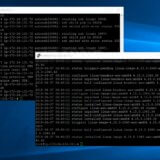目次
1. SNSでトピックを作成
最初に、SNSでトピックを作成します。マネジメントコンソールの「SNS」のページで「Create Topic」を選択します。
次のページの「Topic name」に任意のトピック名(今回は、「dp-docker-topic」を作成)を入れて、トピックを作成します。
このトピックはCloudWatchとLambdaをつなぐだけのものなので、何も設定せずトピックを作成するだけで完了です。
2. CloudWatchでアラームを作成
次に、Slackに投稿したいEC2のCPU使用率のアラームをCloudWatchで作成します。アラーム名やCPU使用率のしきい値などを設定します。
3. Slack APIの「Incoming WebHooks」の設定
https://slackid.slack.com/services/new
「Incoming WebHooks」を検索/選択します
(今回作成したもの↓cats_internal)
Webhook URL
https://hooks.slack.com/services/xxxxx/yyyy/
4. IAMのKMSで暗号キーを作成
次は、IAMのKMSで暗号キーを作成します。マネジメントコンソールの「IAM」のページの左メニューで「暗号キー」を選択します。使いたいリージョンでフィルターをかけ、暗号キーの作成をおこないます。
《★下のコマンドをどこかのサーバで実行する。》
aws kms encrypt –key-id alias/notify-slack-key –plaintext “hooks.slack.com/services/xxxxx/yyyy/zzzzz”
コマンド出力結果
{
“CiphertextBlob”: “aaaaaaaaaa”,
“KeyId”: “arn:aws:kms:ap-northeast-1:awsaccount:key/bbbb-cccc-dddd-eeee-fffff”
}
★Lambdaの設定点線したも参考に。。
ようやくLambda Functionの作成です。Blueprintの選択時に「slack」で検索すると「Cloudwatch-alarm-to-slack」が3種類出てきます。
利用言語が異なるだけなので使いやすいものを選択して下さい。今回はPython2.7のものを選択しました。
(今回作成した notify-slack-blueprint )
今回作成ロール名:notify-slack-role-gggggg
以下、アタッチしているポリシー
・CloudWatchLogsReadOnlyAccess
・AWSKeyManagementServicePowerUser
・AWSLambdaBasicExecutionRole-bbbb-cccc-dddd-eeee-fffff(←デフォルトっぽい)
・notify-slack(←カスタムポリシーを作る)
今回作成したポリシー
・notify-slack
{
“Version”: “2012-10-17”,
“Statement”: [
{
“Effect”: “Allow”,
“Action”: [
“kms:Decrypt”
],
“Resource”: [
“arn:aws:kms:ap-northeast-1:awsacount:key/bbbb-cccc-dddd-eeee-fffff”
]
}
]
}
環境変数が元々セットされていると思うのでパラメータを設定してあげる。
kmsEncryptedHookUrl
ssssss
slackChannel cats_internal
暗号化するKMSキーも作成したKEY名を選択。
====================================================================================
5. Lambdaの設定
マネジメントコンソールの「Lambda」のページのBlueprint選択画面で「cloudwatch-alarm-to-slack」を検索/選択します。今回、言語はPythonにしました。
”’
Follow these steps to configure the webhook in Slack:
1. Navigate to https://<your-team-domain>.slack.com/services/new
2. Search for and select “Incoming WebHooks”.
3. Choose the default channel where messages will be sent and click “Add Incoming WebHooks Integration”.
4. Copy the webhook URL from the setup instructions and use it in the next section.
To encrypt your secrets use the following steps:
1. Create or use an existing KMS Key – http://docs.aws.amazon.com/kms/latest/developerguide/create-keys.html
2. Click the “Enable Encryption Helpers” checkbox
3. Paste <SLACK_CHANNEL> into the slackChannel environment variable
Note: The Slack channel does not contain private info, so do NOT click encrypt
4. Paste <SLACK_HOOK_URL> into the kmsEncryptedHookUrl environment variable and click encrypt
Note: You must exclude the protocol from the URL (e.g. “hooks.slack.com/services/abc123”).
5. Give your function’s role permission for the kms:Decrypt action.
Example:
{
“Version”: “2012-10-17”,
“Statement”: [
{
“Sid”: “Stmt1443036478000”,
“Effect”: “Allow”,
“Action”: [
“kms:Decrypt”
],
“Resource”: [
“<your KMS key ARN>”
]
}
]
}
”’
import boto3
import json
import logging
import os
from base64 import b64decode
from urllib.request import Request, urlopen
from urllib.error import URLError, HTTPError
# The base-64 encoded, encrypted key (CiphertextBlob) stored in the kmsEncryptedHookUrl environment variable
ENCRYPTED_HOOK_URL = os.environ[‘kmsEncryptedHookUrl’]
# The Slack channel to send a message to stored in the slackChannel environment variable
SLACK_CHANNEL = os.environ[‘slackChannel’]
HOOK_URL = “https://” + boto3.client(‘kms’).decrypt(CiphertextBlob=b64decode(ENCRYPTED_HOOK_URL))[‘Plaintext’].decode(‘utf-8’)
logger = logging.getLogger()
logger.setLevel(logging.INFO)
def lambda_handler(event, context):
logger.info(“Event: ” + str(event))
message = json.loads(event[‘Records’][0][‘Sns’][‘Message’])
logger.info(“Message: ” + str(message))
alarm_name = message[‘AlarmName’] #old_state = message[‘OldStateValue’] new_state = message[‘NewStateValue’] reason = message[‘NewStateReason’]
slack_message = {
‘channel’: SLACK_CHANNEL,
‘text’: “%s state is now %s: %s” % (alarm_name, new_state, reason)
}
req = Request(HOOK_URL, json.dumps(slack_message).encode(‘utf-8’))
try:
response = urlopen(req)
response.read()
logger.info(“Message posted to %s”, slack_message[‘channel’])
except HTTPError as e:
logger.error(“Request failed: %d %s”, e.code, e.reason)
except URLError as e:
logger.error(“Server connection failed: %s”, e.reason)
6. 作成したロールにポリシーを追加
最後に、先ほどIAMで作成したロールにポリシーを追加します。



